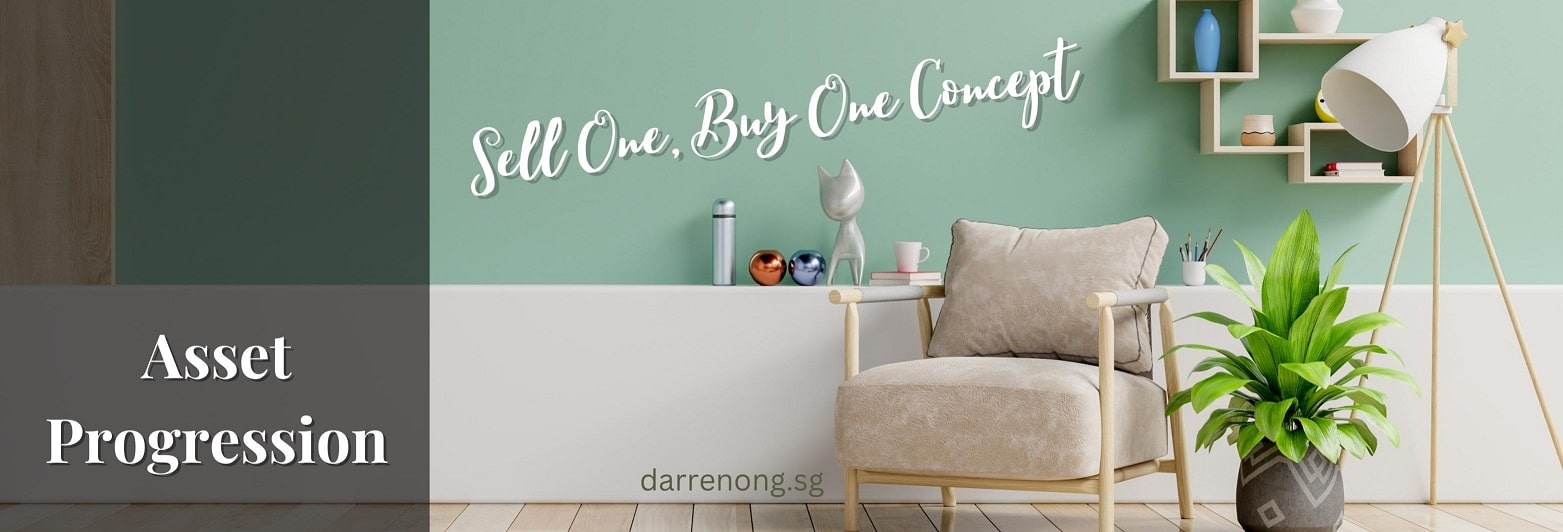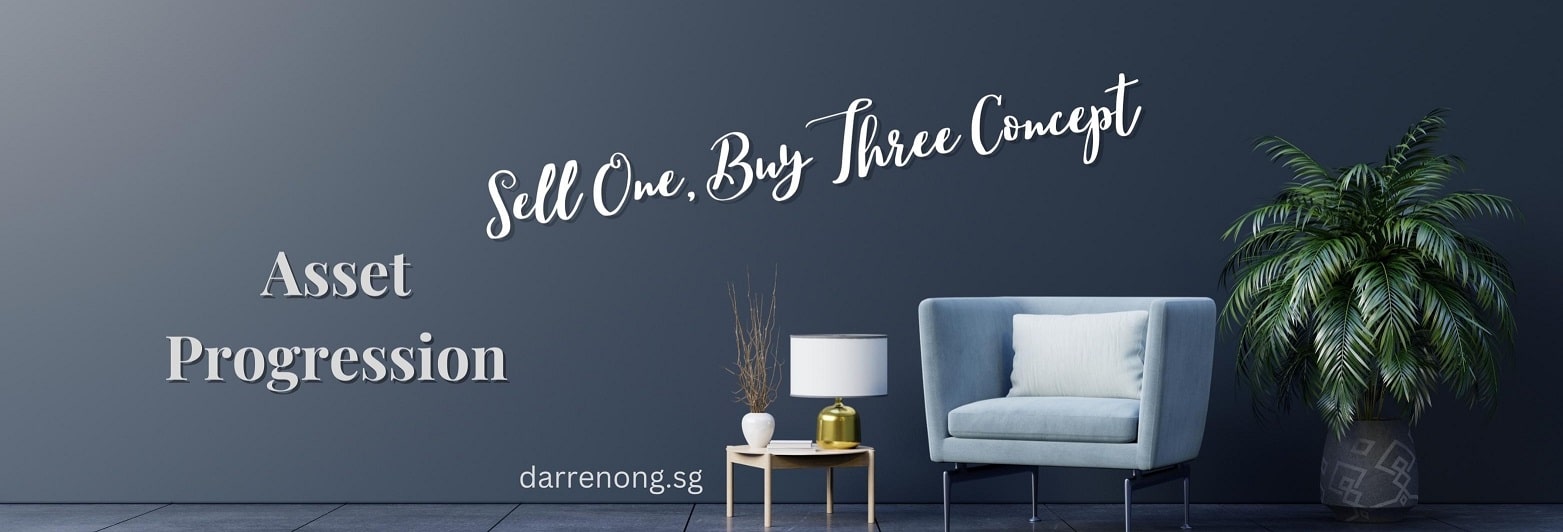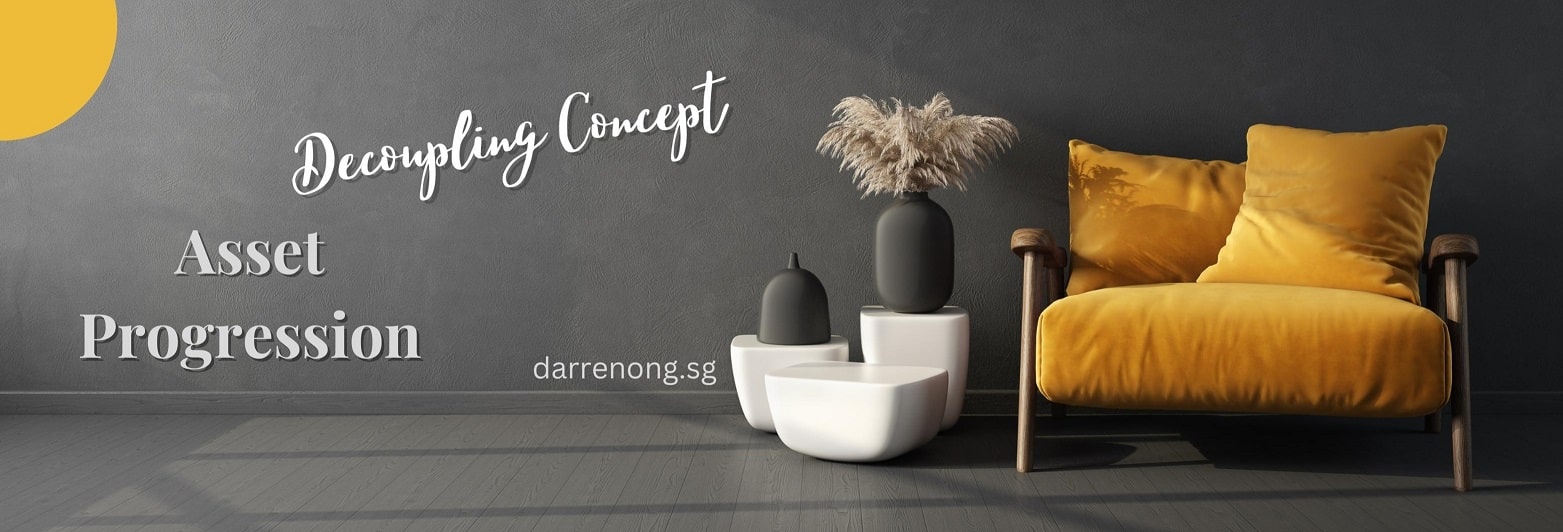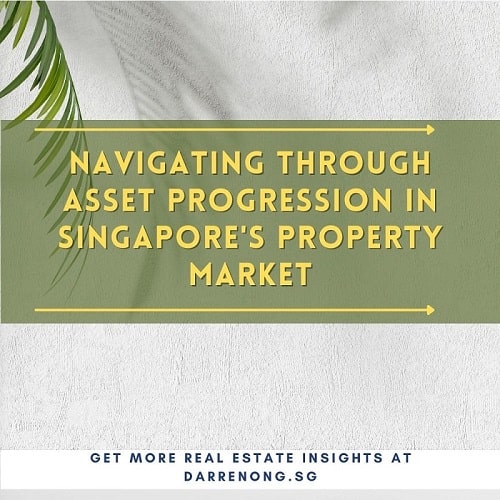In Singapore, where space is limited, and many people want property, asset progression is becoming a top choice for those looking to invest in real estate. Think of it as moving up the property ladder step by step. It starts with buying a simple property and, as its value increases, using that to buy a bigger or better or more property. This isn’t just about buying a home; it’s about making that home help you earn more money over time. Asset progression is becoming popular because of how quickly Singapore grows with new buildings and infrastructures. Also, with the property being a big deal and a major investment for many in Singapore, everyone wants their money to work smarter in the real estate market. As more people catch on to this idea, it’s clear that Singaporeans aren’t just looking to buy a property – they want their property to grow in value too. But how should one go about executing asset progression? In this article, we will share the concept and case study of property asset progression in Singapore.
Introduction to Property Asset Progression
Asset Progression, in simple terms, is like playing a real-life game of Monopoly. Remember how in Monopoly, you start by purchasing smaller properties. As the game progresses, you trade or combine these to acquire more expensive, lucrative ones? Similarly, asset progression is about systematically moving up the property ladder in the real world. It’s the process of starting with what you can afford, watching its value grow, and then leveraging that growth to step up to more valuable property as the end goal.
Now, let’s relate this to Singapore’s context. Given the nation’s limited land and ever-growing demand, properties here can be likened to gold mines that, when tapped correctly, yield rich dividends. Singapore’s urban planning, continuous infrastructure development, and stable socio-economic landscape make its property market a magnet for appreciation. When we talk about Asset Progression, we’re basically discussing how Singaporeans can make the most of this appreciation.
But why is it important? Well, given Singapore’s escalating costs and limited space, more than just owning a property is needed. Many want to see their initial investments blossom into more significant returns. This way, one doesn’t just secure a place to live but also ensures that their hard-earned money consistently grows in value for retirement.

The Mechanism of Asset Progression
At its heart, asset progression is about the principle of buying properties, holding them until they appreciate in value, and then advancing to a higher-valued property. Think of it as climbing a ladder. With each rung (or property) you climb, you leverage the last step to boost your wealth. Using the value from one’s current property, you can often secure loans or additional capital to invest in even more promising properties.
Many started by owning an HDB flat but progressively upgraded to private property. Some may even progress to owning multiple properties for rental income while waiting for capital appreciation in the near future.
Profiting from Asset Progression: 5-15 Year Horizon
Singapore’s property values, given the right conditions, naturally rise. Within a span of 5-15 years, well-planned investments can yield commendable profits. As mentioned earlier, an individual might begin with an HDB flat. As this flat’s value increases, they could sell it to buy a private condominium. This buying, growing, and upgrading cycle can lead to significant portfolio expansion over time.
Take Mr. Tan’s hypothetical journey: He bought an HDB flat in an emerging Singapore area. Over 5 years, with the inclusion of new amenities, transportation facilities, and community developments, his flat’s value shot up by 20%. Spotting an opportunity, Mr. Tan sells and, leveraging the growth, acquires a condo in a prime district. In the next 5 years, his condominium’s value grows even more.
Factors to consider when executing Asset Progression
Here are some crucial factors to consider when executing Asset Progression in Singapore, with a focus on government regulations, mortgage considerations, and the importance of prudence:
Government Rulings & Regulations:
- Additional Buyer’s Stamp Duty (ABSD): Depending on whether you’re a Singaporean citizen, permanent resident, or foreigner and the number of properties you own, the ABSD rates can vary. This is what most Singapore property investors want to avoid. Check the IRAS website for the latest ABSD rates and liabilities you may need to note. Here is the reference website for you: IRAS Website about Additional Buyer’s Stamp Duty (ABSD).
- Loan-to-Value (LTV) Limits: This refers to the loan amount you can take relative to the property’s value. The LTV limit can affect how much down payment you need. The two considerations for LTV are the purchaser’s age and the number of housing loans the purchaser currently has.
- Total Debt Servicing Ratio (TDSR): This framework ensures financial prudence by limiting individuals’ spending on debt repayments based on a percentage of their gross monthly income. As of 16 December 2021, the TDSR rate is at 55%. Check the MAS website for the latest TDSR rate and the minimum requirement you need to note. Here is the reference website for you: MAS Website about Total Debt Servicing Ratio (TDSR).
- Seller’s Stamp Duty (SSD): If you sell your residential property within a specific timeframe from the date of purchase, you might be liable for SSD. As of 17 March 2017, the SSD rate is up to 12% of the actual price or market value, whichever is higher. You may refer to the IRAS website for the latest SSD rate and the liabilities that you may need to note: Here is the reference website for you: IRAS Website about Seller’s Stamp Duty (SSD).
Mortgage Considerations:
Below are some of the considerations that you need to take note and it is advisable to speak to a mortgage specialist to find out more and secure your in-principal approval to determine your mortgage loan size eligibility.
- Interest Rates: Monitor prevailing interest rates, which can influence your monthly mortgage payments.
- Loan Tenure: The period you choose to repay your loan can impact your monthly cash flow and overall interest payment. The longer, the lower the monthly installment.
- Refinancing Options: Be aware of the possibility of refinancing your mortgage to benefit from better future interest rates or terms.
- Lock-in Period: Some loans have a period where you’re “locked in” and might incur penalties for early repayments or refinancing. The shorter, the better. It can range from 1 – 3 years.
- Loan quantum: This will determine your budget size and potentially save on additional lump sum payments from your saving for the purchase.
Prudency in Asset Progression:
- Market Research: Understand the current property market’s dynamics and potential future trends.
- Financial Health: Regularly assess your financial health to ensure you can manage your mortgages without overstretching.
- Exit Strategy: Always plan how and when you might want to sell or lease the property.
- Risk Assessment: Every property purchase has inherent risks. Recognizing these risks and deciding if they are manageable or worth taking is essential.
- Long-Term Goals: Align your asset progression strategy with your long-term financial and personal goals.
- Professional Advice: Consider seeking advice from property experts or financial advisors to make informed decisions.
These factors provide a comprehensive roadmap for individuals looking to delve into asset progression in Singapore, ensuring you’re well-informed and prepared for the journey.
Asset Progression Case Study
With rules like the Additional Buyer Stamp Duty for housing in Singapore, we see more of the following Asset Progression cases these days.

Sell One, Buy One Property Concept
Case Study 1: Unlocking Asset Progression through the “Sell One, Buy One” Approach in Singapore
The Lim Family’s Journey:
Mr. Lim, his wife, and their two children. They’ve lived in a cozy 3-room HDB flat in Tampines for years, enjoying the convenience and community spirit of heartland living. As their children grew older and the family’s needs changed, they contemplated upgrading their living space. Like many Singaporeans, they’d heard of asset progression and were intrigued by its potential.
Initial Situation: The Lim’s HDB flat, purchased at S$250,000 a decade ago, was now valued at approximately S$400,000, thanks to Singapore’s resilient real estate market and consistent neighborhood developments. They were financially prepared to make a leap with Mr. Lim’s stable job in finance and his wife’s blossoming home business.
The “Sell One, Buy One” Decision: The Lims were introduced to the “Sell One, Buy One” concept. The strategy was simple: sell their current HDB flat and use the proceeds as a hefty down payment for a private condominium, tapping into the asset progression ladder.
The Process:
- Sale of HDB Flat: Their Tampines flat, being in a sought-after location with amenities, quickly found a buyer. The sale proceeds provided them with a considerable amount for their next investment.
- Hunting for the Right Condominium: With a budget in mind and desires for specific facilities like a swimming pool and gym, the Lims searched in emerging areas like Punggol and Sengkang. These regions, characterized by rapid infrastructural growth, promised potential property appreciation.
- Financial Prudency: While tempted by luxurious, sprawling condos, the Lims practiced prudency. They chose a mid-sized unit in a new development, ensuring they stayed within their finances.
The Outcome: The Lims moved into their new condo within a year. The transition wasn’t just about enjoying upscale amenities but was also a calculated step in their asset progression journey. Given Singapore’s burgeoning property market, the condominium’s value was expected to appreciate faster than their previous HDB flat.
Reflection: The “Sell One, Buy One” approach allowed the Lims to upgrade their lifestyle while ensuring their property remained a growing asset. By balancing aspiration with financial prudency and leveraging Singapore’s dynamic real estate landscape, they’ve set a foundation for future wealth and security.
Conclusion: The journey of the Lim family serves as a testament to the potential of asset progression in Singapore. By understanding the “Sell One, Buy One” concept and strategically navigating the property market, Singaporeans can transform their primary residence into a wealth-building tool.

Sell One, Buy Two Properties Concept
Case Study 2: Maximizing Opportunities with the “Sell One, Buy Two” Strategy in Singapore
Journey of Ravi and Priya:
Ravi and Priya a married couple in their mid-30s. Both work in well-paying jobs, Ravi in finance and Priya in healthcare. For a decade, they’ve lived in a 5-room HDB flat in Woodlands, a space they cherished but also viewed as an investment. With aspirations of climbing the asset progression ladder, they contemplated a strategic leap into Singapore’s promising property market.
Initial Situation: Their Woodlands flat, acquired at S$350,000 ten years back, had now appreciated to S$550,000, thanks to regional developments and Singapore’s consistent real estate growth. With combined savings and stable incomes, the couple felt it was time to expand their property portfolio.
The “Sell One, Buy Two” Decision: Ravi, and Priya are keen on the “Sell One, Buy Two” model. The plan was to sell their HDB flat and invest the proceeds in two private properties: one for living and one for investment, registering each property under their individual names, as this way, both of them will have one property count under their name which they do not have to pay ABSD. Suppose they combine their name to buy both properties. In that case, ABSD will be payable for the second property as the number of property counts is two for the second property purchase. The ABSD rate payable at the point this article is written is 20% of the purchase price.
The Process:
- Sale of HDB Flat: Benefitting from the Woodlands flat’s prime location, providing substantial funds for their next investments.
- Choosing a Residence: The couple bought a private condo in a blossoming area. This new residence, registered under Ravi’s name, ensured them a comfortable lifestyle with modern amenities.
- Smart Investment: With the remaining capital, Priya, under her name, invested in a private apartment in a different growth area, aiming to rent it out and reap both rental income and future appreciation benefits.
- Balancing Finances: The couple was prudent, ensuring they balanced their loans, factored in maintenance costs, and kept a financial buffer for any unexpected rainy day. Their strategy was to derive maximum value without overstretching.
The Outcome: Within a couple of years, not only were Ravi and Priya relishing life in their new condo, but Priya’s investment property also began yielding a regular rental income. This two-pronged approach meant they were optimizing their assets, boosting income streams, and setting themselves up for promising asset appreciation.
Reflection: The “Sell One, Buy Two” approach provided Ravi and Priya more than just a residential upgrade. It reshaped their financial landscape, creating a dual source from property — one for living, the other as a growing investment. Their foresight to tap into Singapore’s robust property market has positioned them well for future wealth accumulation.
Conclusion: Ravi and Priya’s journey epitomizes the potential of asset progression using the “Sell One, Buy Two” tactic in Singapore. By harnessing such methodologies, Singaporean couples can elevate their living standards and robustly secure their financial trajectory.

Sell one buy three or more properties concept
Case Study 3: Expanding Horizons with the “Sell One Buy Three” Strategy in Singapore
The Adventures of Leon and May:
This dynamic couple in their late 30s have enjoyed successful careers, Leon in logistics and May as a corporate trainer. Residing in a spacious 5-room HDB flat in Ang Mo Kio, they’ve always viewed their home as both a haven and a strategic asset. With their ambitions set high, they aimed to navigate the intricate property market of Singapore and achieve substantial asset progression.
Initial Situation: Their HDB flat, purchased at S$510,000 around 12 years ago, had seen its value shoot up to S$700,000, thanks to the city-state’s relentless urban development and infrastructural boosts. Armed with this equity and their accumulated savings, they envisioned a multi-pronged property expansion.
The “Sell One Buy Three” Decision: Leon and May decided to embarked on the “Sell One Buy Three” route. The idea was to sell their HDB, buy two residential properties under their respective names, and invest in industrial property to diversify their portfolio after they settled the purchase of the residential properties.
The Process:
- Sale of HDB Flat: Their Ang Mo Kio flat, given its prime locality, grants them a substantial amount to strategize their investments.
- Residential Expansion: Leon bought a condo in the emerging Bishan area, which they always look forward to moving there. At the same time, May opted for an apartment in another growth corridor. Both properties promised modern amenities and potential appreciation.
- Industrial Investment: With their sights set on creating a rental income stream, the couple decided to jointly invest in an industrial property in a bustling hub. Recognizing the rising demand for industrial spaces due to Singapore’s business boom, this was an astute move.
- Managing Finances: Leon and May meticulously balanced their finances with multiple properties in play. They factored in maintenance costs, potential rental incomes, and loan commitments, ensuring a holistic and sustainable financial plan.
The Outcome: While the couple comfortably settled into Leon’s condo, May’s apartment was rented out, generating a consistent monthly income. The industrial property also found a long-term tenant, further bolstering their rental revenues. Within a few years, their asset appreciation potential multiplied, and their financial outlook seemed brighter than ever.
Reflection: For Leon and May, the “Sell One, Buy Three” strategy wasn’t just about property acquisition but financial foresight. They didn’t stop at residential properties but ventured into the industrial segment, tapping into the diverse avenues of Singapore’s property market.
Conclusion: The journey of Leon and May serves as an inspiration in the realm of asset progression. By strategically diversifying their property investments, they’ve laid a blueprint for other aspiring Singaporeans, showcasing how one can broaden their horizons and achieve exponential growth.

Decoupling concept (Only for private property owners)
Case Study 4: Navigating the “Decoupling” Terrain in Singapore’s Real Estate Market
Henry and Emily’s Calculated Leap:
Henry and Emily, a power couple in their mid-40s, had flourishing careers. As proud owners of a private condo in Orchard Road for the past decade, they saw an upward growth in its value. However, they remained vigilant for prospects in Singapore’s property market.
Initial Scenario: Their private condo, initially bought at S$1.9 million, had soared to an impressive S$3 million value, thanks to the evergreen real estate growth in Singapore. With this appreciation and a vision for more, they contemplated tweaking their property ownership structure.
The “Decoupling” Maneuver: Decoupling, they discovered, can be actualized when one spouse sells their portion of the property to the other, rendering the latter as the sole proprietor. This would free up the selling spouse from owning any residential property, enabling them to purchase another without the additional duties. Intrigued and persuaded, the couple embraced this avenue.
The Journey:
- Condo Decoupling: Henry sold his share in the Orchard Road condo to Emily. This meant Emily became the exclusive owner, while Henry was strategically unburdened.
- New Investment Avenues: Post-decoupling, Henry was positioned as a first-time buyer in the property landscape, granting him flexibility and advantages in the market.
- Astute Purchase: Henry earmarked a modern apartment in the RCR Region, near the MRT Station, not for personal use but to harness the prime rental opportunities the locale promised.
- Safeguarding Finances: They meticulously monitored their financial commitments, from mortgage rates to maintenance fees, throughout their decoupling and reinvestment.
The Outcome: Emily retained and cherished the Orchard Road condo’s growth, while Henry’s modern apartment acquisition drew a consistent, lucrative rental income. Their investment outlook, now dual-faceted, was set on an elevated path of growth.
Retrospect: To Henry and Emily, decoupling wasn’t just paperwork—it was a discerning leap, a decision to diversify their property assets without incurring excess charges. Their journey underscored the rewards of understanding the intricacies of Singapore’s property market.
Conclusion: Henry and Emily’s voyage sheds light on the promise of the “Decoupling” tactic in Singapore. By reshuffling their ownership and diving into multiple property investments, they penned a playbook on optimizing growth and income streams.

Some common pitfalls of executing property Asset Progression
Every way to grow your money has its ups and downs. The key? Knowing the best tricks and getting good advice before jumping in.
Want to do well with Property Asset Progression in Singapore? Thoughtful planning is a must. And chatting with an expert property agent can be a game-changer. It might not be super complicated, but there are steps you shouldn’t miss.
Here are some pitfalls to watch out for:
Pitfall #1 – Picking the Wrong Plan
When upgrading your property in Singapore, it’s like following a roadmap. You might get lost if you skip steps or pick a path without preparing. For young couples buying their first home, it’s often wiser to go for a BTO flat than a fancy private condo. Why? With BTOs, they could get up to $80,000 from the HDB housing grant. Plus, the profit can be pretty significant when selling the BTO after the minimum occupation period (MOP) of 5 years. This money can then be a big help for their next property move.
Pitfall #2 – Not Doing Your Homework
Buying property is about something other than getting the cheapest deal. It’s about finding a home that’ll grow in value. If you’re looking to upgrade your property, you’ve got to research and see how the area might develop. Don’t get carried away by pretty designs or extras. What you want is a home that’s priced well and will rise in value. Jumping in without understanding the Singapore property market or a money plan can make things challenging later.
Pitfall #3 – Waiting Too Long
You might’ve heard about “timing the market” in property talks. But waiting too long for the “perfect” time can mean missing out. Age matters, too, especially when getting loans in Singapore. The older you are, the harder it might be to get a big loan. For instance, there’s a rule in Singapore about how long your housing loan can be, and your age counts in that. So, a 28-year-old might get a more significant loan percentage for a condo than someone who’s 46. The longer you wait to buy property, the harder it might be to borrow money. “
“Always buy to wait and not wait to buy”
Pitfall #4 – Not Understanding the Steps or Procedures
Jumping into the property world without knowing the rules can be confusing. It’s like trying to play a game without knowing the rules. Knowing what to do and when can make your property journey smoother and smarter, whether it’s about paperwork, fees, or timelines. Always learn the basics before diving in.
Conclusion
To put it succinctly, property asset progression is about smartly navigating the property landscape. It’s about not just resting on one’s laurels but continuously seeking opportunities to grow one’s investments.
Understanding and leveraging asset progression can transform moderate investments into sizeable fortunes in Singapore’s pulsating property market.
Always remember that while the concept seems promising, every property move comes with its own set of risks. So, it’s imperative to be informed and seek expert advice when playing this real-life game of Monopoly. Lastly, always be prudent, have a safety net reserve, and do not overleverage.
Read Other Article:
Please note that the above case study are just an illustration for your understanding only.




